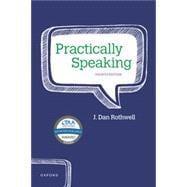Widely praised for its conversational tone and clear advice, Practically Speaking is the public speaking textbook your students will actually read. Filled with engaging stories and examples, sound scholarship and recent research, and useful tips and tricks, Practically Speaking shows students how to get started, practice thinking critically, and ultimately develop their own voice. Practically Speaking is a winner of the Textbook & Academic Authors Association's Textbook Excellence Award.
Instructors may find course preparation tools and more details on our robust digital offerings at www.oup.com/he/rothwell-ps4e.











